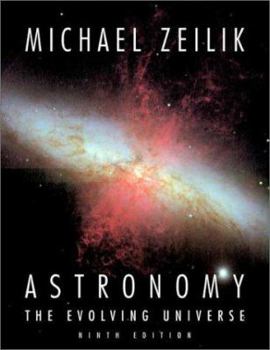Astronomy: The Evolving Universe
Select Format
Select Condition 
Book Overview
Designed to provide readers with an enriched sense of the astronomical world, this edition continues to explain how astronomers think about the cosmos and describes the full range of the astronomical... This description may be from another edition of this product.
Format:Paperback
Language:English
ISBN:0521800900
ISBN13:9780521800907
Release Date:January 2002
Publisher:Cambridge University Press
Length:572 Pages
Weight:2.80 lbs.
Dimensions:0.9" x 8.5" x 10.8"
Customer Reviews
2 ratings
Starry, starry night...
Published by Thriftbooks.com User , 20 years ago
Zeilik's book is one of the earliest systematic astronomy texts I ever read, beginning with the third edition back in 1982. That edition had four primary sections - Part I: Changing Concepts of the Cosmos; Part II: The Planets, Past and Present; Part III: The Universe of Stars and Galaxies; and Part IV: Cosmic Evolution. Part I looks at the general structure of the universe, how it was conceived in the past, and how it is viewed today. Much of what is covered here falls under the general heading of cosmology. Zeilik has an interest in the history of astronomy, and it shows clearly in the text. He explores, among other topics, the Anasazi prehistoric astronomy discoveries, the Ptolemaic geocentric model, Tycho Brahe/Kepler's achievements, the discoveries of Newton and Galileo, and finally the birth of modern astrophysics. Some basic physics is introduced along the way, to make sense of radiation and optics, as well as gravitation and space-time concepts.Part II looks at the nine planets of our solar system, including their satellites (moons), and the asteroids and other solar system objects (comets, etc.). Planetary sciences are among the fastest developing sciences around, so a lot of the information contained here is basic, and some updating is required. There is no mistake that the most current version of this text is now in its ninth edition. The final chapter in this subject looks at some of the theories of the origin and development of the solar system. Part III looks at the universe beyond the planets, looking first at the sun as a typical small star, and then going further afield to look at the Milky Way, our local galaxy in some detail. This includes a look at other major formations and stars within the galaxy - some named stars of interest as well as celestial objects such as nebulae, and a discussion of interstellar distances and distribution (Hertzsprung-Russell diagram, etc.). The structure, kinematics and dynamics of spiral galaxies are explored, and then other types of galaxies (elliptical, etc.) and galactic clusters. The final section, Part IV, looks at general evolution and development of the universe. Stellar evolution is the first subject, as one of the primary vehicles of universal development. The different ways in which a star dies are explored - white dwarves, neutron stars, supernovae, black holes, pulsars. The larger ideas of the origins and ultimate fate of the universe (cosmology again, at the end) are explored, including a brief discussion of the origins of life in the universe, and short discussions on topics such as SETI (called CETI here, Communication with ExtraTerrestrial Intelligence). One of the useful aspects of this text is the 'Beyond the Book' sections after each chapter. These include information about periodicals (often the best way to find the latest information on astronomy topics), additional books and other resources. There are learning objectives listed at the beginning of each chap
Great book for all
Published by Thriftbooks.com User , 24 years ago
If you were ever interested in what is going on above in heavens, but didn't want to trouble yourself with too much equations and other non-esential stuff, then this is the book for you. It is a textbook, and it reads as a textbook. You'll find that everything is included: from our Solar system, to the nuclear processes in the stars, to the black holes. Descriptions are as they should be for the non-pros: comprehensive and simple (yet not trivial), well presented (love those many color pictures) and to the point. Great for an occasional star-gazer as well as astronomy students to revise their knowledge. And the Night Spectra Quest is a neat beginner's tool to examining star spectra. If you get more interested after studying this book, I recommend "An Introduction to Modern Astrophysics", which goes more deeply into the study of astrophysics and cosmology.






